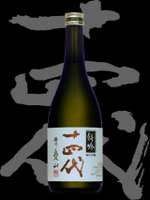The first of series of events to come was held at EN Japanese Brasserie, featuring portfolio of over 60 selections from Banzai Beverage Corporation, covering sakés, shochu, and wines that are not yet available in the States. The event was open to trade and press.
 Gold Medal: Hiroki Tokubetsu Junmai (SMV: +2, Acidity: 1.5, Rices: Yamadanishiki & Gohyakumangoku, Seimaibuai: 50% & 55% respectively, Yeast: N/A) from Fukushima Prefecture. "Tokubetsu" means “special” in Japanese, and this designation is used to indicate a unique production method in this case. Hiroki is a blend of two different rice polished to a different degree, Yamadanishiki at super premium daiginjo-grade 50% and Gohakumangoku at premium ginjo-grade 55%. This blended Scotch-like approach resulted in a saké with tremendous balanced, rich body, and expressive flavors of tropical fruits, melon, and strawberries. Based on the taste, you would never know that this is from a new kura (established 1999), and the brew master never formally studied the craft! Should this mildly dry saké become available in the US, it is very well worth trying.
Gold Medal: Hiroki Tokubetsu Junmai (SMV: +2, Acidity: 1.5, Rices: Yamadanishiki & Gohyakumangoku, Seimaibuai: 50% & 55% respectively, Yeast: N/A) from Fukushima Prefecture. "Tokubetsu" means “special” in Japanese, and this designation is used to indicate a unique production method in this case. Hiroki is a blend of two different rice polished to a different degree, Yamadanishiki at super premium daiginjo-grade 50% and Gohakumangoku at premium ginjo-grade 55%. This blended Scotch-like approach resulted in a saké with tremendous balanced, rich body, and expressive flavors of tropical fruits, melon, and strawberries. Based on the taste, you would never know that this is from a new kura (established 1999), and the brew master never formally studied the craft! Should this mildly dry saké become available in the US, it is very well worth trying. Silver Medal: Juyondai Junmai Daiginjo "Banshu Aiyama" (SMV: +2, Acidity: 1.3, Rice: Aiyama, Seimaibuai: 40%, Yeast: Yamagata) by Takagi Brewery from Yamagata Prefecture. Interestingly, Juyondai is very popular in Japan, and some up- and- coming sakés are referred to as the "Next Juyondai," including Hiroki. Based on my ranking, it appears that the student has become the teacher! The teacher is still a superior brew, with highly aromatic and expressive flavors of cantaloupe and lychee that gives way to a harmonious sweet/bitter finish.
Silver Medal: Juyondai Junmai Daiginjo "Banshu Aiyama" (SMV: +2, Acidity: 1.3, Rice: Aiyama, Seimaibuai: 40%, Yeast: Yamagata) by Takagi Brewery from Yamagata Prefecture. Interestingly, Juyondai is very popular in Japan, and some up- and- coming sakés are referred to as the "Next Juyondai," including Hiroki. Based on my ranking, it appears that the student has become the teacher! The teacher is still a superior brew, with highly aromatic and expressive flavors of cantaloupe and lychee that gives way to a harmonious sweet/bitter finish. Bronze Medal: Isojiman Junmai Ginjo (SMV: +5, Acidity: 1.3, Rice: Yamadanishiki, Seimaibuai: 50%, Yeast: N/A) from Shizuoka Prefecture. A very good saké, one of the first ones I tasted as it was at Table #1. It may have placed higher, if the saké was slightly more chilled. This smooth and medium- bodied saké featured flavors of melon and pineapple, and had a mildly spicy finish possibly due to the serving temperature.
Bronze Medal: Isojiman Junmai Ginjo (SMV: +5, Acidity: 1.3, Rice: Yamadanishiki, Seimaibuai: 50%, Yeast: N/A) from Shizuoka Prefecture. A very good saké, one of the first ones I tasted as it was at Table #1. It may have placed higher, if the saké was slightly more chilled. This smooth and medium- bodied saké featured flavors of melon and pineapple, and had a mildly spicy finish possibly due to the serving temperature. Eye-opener of the Night: Here, I'll deviate from my usual practice and nominate a non-saké for this award, but there is a good reason. I gave the award to triplet of Hozan line of Imo Shochu: Kichho Hozan, Tomi No Hozan, and Satsuma Hozan. The difference between the three was in the yeast! By trying these three, I learned how a black yeast (lean, focused, deep), yellow yeast used for saké (fruitier and mellower), and standard yeast (gamy, funky) affect the flavors of Imo Shochu. This inevitably made me pay more attention to the yeast used for sakés.
Eye-opener of the Night: Here, I'll deviate from my usual practice and nominate a non-saké for this award, but there is a good reason. I gave the award to triplet of Hozan line of Imo Shochu: Kichho Hozan, Tomi No Hozan, and Satsuma Hozan. The difference between the three was in the yeast! By trying these three, I learned how a black yeast (lean, focused, deep), yellow yeast used for saké (fruitier and mellower), and standard yeast (gamy, funky) affect the flavors of Imo Shochu. This inevitably made me pay more attention to the yeast used for sakés.

No comments:
Post a Comment